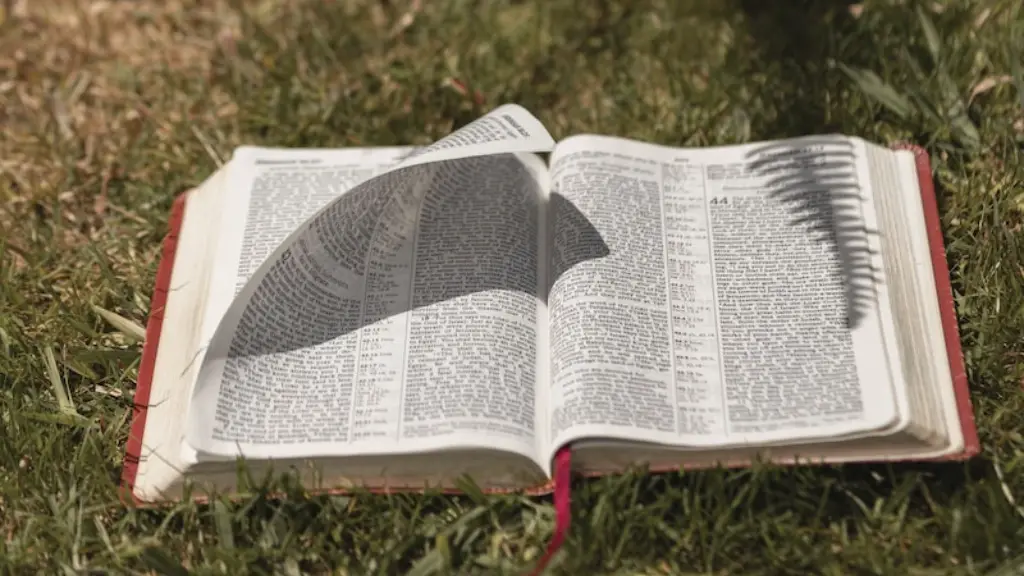The Bible is an ancient book full of spiritual wisdom. One of its most ubiquitous symbols is the tree, which appears throughout scripture in many contexts. Its ubiquity in the Bible is an indication that the tree has been a major source of both literal and figurative sustenance throughout human history.
As a physical attribute to the landscape, trees are indicators of the longevity of life in the Bible. In Genesis 2:9 it states, “And out of the ground the Lord God made to grow every tree that is pleasant to the sight and good for food.” Here we see the tree likened to food and sustenance, two essential provisions while in the same chapter, the fourth tree is listed as “the tree of the knowledge of good and evil.” This tree has since been interpreted by scholars as a symbol of separation from the original purity of God’s creation.
Trees can also be symbolic of continued spiritual growth and renewal. In Psalm 1:3, “He is like a tree planted by streams of water that yields its fruit in its season, and its leaf does not wither. In all that he does, he prospers.” Here we see that growth, no matter how small, can lead to eternal blessings. Trees are also used to represent things of divine origin in the Bible. For example, in Jeremiah 17:8, it states “He will be like a tree planted by water, that sends out its roots by the stream, and does not fear when heat comes, for its leaves remain green, and is not anxious in the year of drought, for it does not cease to bear fruit.” Here we can see the tree symbolizing strength, resilience and faithfulness. This image of the tree being planted firmly in the ground and being unaffected by external factors is also emblematic of the idea of security in one’s faith, no matter what struggles one may face.
Other times the tree is used to represent the development of the relationship between individuals, such as between Abraham and God in the Book of Genesis, or the relationship between mankind and God in the Garden of Eden. In Genesis 22:2, it states “He said, ‘Take your son, your only son Isaac, whom you love, and go to the land of Moriah, and offer him there as a burnt offering on one of the mountains of which I shall tell you.’” Here the tree symbolizes the covenant between Abraham and God, as Abraham is willing to part with his beloved son despite being called to do so. This covenant was the result of Abraham’s faithfulness and loyalty to God.
The tree symbol is heavily featured in the Bible and has been interpreted by scholars as having a variety of different meanings. It is often used to represent sustenance and nourishment, as well as spiritual rebirth and growth, security, and relationships. As such, it is clear that the tree is a powerful symbol in the Bible, and understanding its various meanings can provide insight into how it has been and can be used in our own lives.
Sacrifice
One major theme of the tree symbol as presented in the Bible is sacrifice. In many scriptural contexts, the tree is used to represent the Biblical practice of sacrificing something in order to gain a greater reward or blessing. For example, Abraham was asked to sacrifice Isaac, his beloved son. Here, we can see the tree as a symbol of the willingness to give up something precious in order to receive something even more important in the long run. This powerful story not only shows how Abraham was willing to sacrifice his son out of faith and understanding of the divine plan, but also reveals how God was willing to reward Abraham’s loyalty with a greater blessing.
The same theme of sacrifice is also presented in the story of Jesus, as he himself was sacrificed in order to save all of humanity. By turning the tree into a symbol of sacrifice, it is easy to make the connection between this symbol and Jesus’ sacrifice for sins. Such an interpretation has the power to both educate and inspire the faithful, as it reminds them of the ultimate price that was paid for their sins.
Strength
The tree symbol is also used to represent strength and resilience in the Bible. In Genesis 2:9, when God made the first tree, it was described as “pleasant to the sight and good for food.” Here, the tree is described as a source of sustenance and nourishment, providing a form of sustenance to mankind. This image of the tree providing nourishment can be interpreted as a symbol of strength and resilience, as the tree is able to withstand all sorts of different conditions while still providing sustenance.
The same concept can also be seen in Jeremiah 17:8, when the tree is said to “send out its roots by the stream, and does not fear when heat comes, for its leaves remain green, and is not anxious in the year of drought, for it does not cease to bear fruit.” This image of the tree being unaffected by external factors is also emblematic of the idea of security in one’s faith, no matter what struggles one may face. Just as the tree continues to bear fruit even in times of drought, so too can someone find comfort and sustenance through their faith, even in the midst of great difficulty.
Resurrection
Another major theme of the tree symbol as presented in the Bible is that of resurrection. The tree is often mentioned in relation to new life and renewal, as in Psalm 1:3, “He is like a tree planted by streams of water that yields its fruit in its season, and its leaf does not wither. In all that he does, he prospers.” Here, the tree is used to symbolize ongoing spiritual growth and development. This image of the tree rooted firmly in streams of water representing ongoing sustenance and provision can be seen as a powerful metaphor for resurrection and new life.
The same theme of resurrection can also be found in the story of Jesus. Jesus’ death and resurrection is a powerful reminder that even in the darkest circumstances, hopeful new beginnings can be possible. As such, the tree in the Bible can be seen as a symbol of hope and renewal, a reminder that even when faced with adversity, a brighter future is still possible.
Protection
Finally, the tree symbol is also used in the Bible to represent protection and support. In Isaiah 32:2, it states “A king will reign in righteousness, and princes will rule in justice. Each will be like a hiding place from the wind, a shelter from the storm, like streams of water in a dry place, like the shade of a great rock in a weary land.” Here, the tree is used to represent a safe place, a shelter from the harshness of the world.
The same concept of protection can be seen in Jesus’ parables, such as the parable of the sower. Jesus spoke of the seed being planted in good soil, where it will then bear fruit. Here, the soil can be seen as a form of protection and support, as it gives the seed the ability to take root and grow, much like the tree providing shelter and support to those who are in need. Just as the tree can give protection, so too can Jesus’ parables offer protection and guidance to those who trust in him.
Fertility
The tree is also a major symbol of fertility in the Bible. In the Book of Genesis, the fourth tree mentioned is the tree of life, symbolizing the cycle of life and death, which is a major theme in all of scripture. Just as the tree’s roots take in nourishment from the ground, so too can the person receiving nourishment from the tree of life receive spiritual sustenance. Moreover, the tree is seen as a physical reminder of fertility and renewal, a sign of hope in a land with limited resources.
This idea is also prevalent in Jesus’ parables, where he speaks of the seed growing and providing plenty of fruit. Here, the tree symbolizes fertility and abundance, again a reminder that life can be full of abundance and joy if one puts trust and faith in God. Furthermore, this same symbol of the tree can also be found in Jesus’ teachings, such as the parable of the sower, and the concept of living in the Kingdom of God. The reference to the tree in these instances reinforces the idea that there is possibility for rebirth and beauty amidst the struggles of life.
Growth
The tree is also a major symbol of growth in the Bible. In Psalm 1:3, it states “He is like a tree planted by streams of water that yields its fruit in its season, and its leaf does not wither. In all that he does, he prospers.” Here, the tree is used to symbolize ongoing growth and development, as it continues to bear fruit even in the midst of drought. This image of the tree being consistently nourished by streams of water can be interpreted as a metaphor for spiritual growth and renewal. As such, the tree is a powerful symbol of growth, and understanding its various meanings can provide insight into how it can be used in our own lives to promote spiritual growth.
Similarly, Jesus often used the tree as a metaphor for growth and development. In his parables, Jesus often speaks of the seed being planted in good soil, yielding plenty of fruit. In this context, the tree acts as a reminder of the process of growth and development, from planting a seed to watching it blossom into something beautiful and abundant. Just as the tree grows, so too can individuals continue to grow in their spiritual journey, with faith in God providing strength and sustenance along the way.




